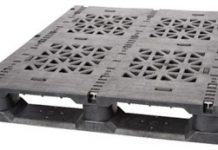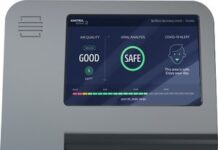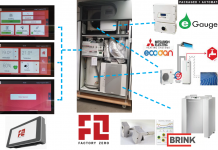by Debra Fiakas CFA
In early December 2014, Energy Recovery (ERII: Nasdaq) staged an analyst and investor event in New York City principally to introduce its most recent technology innovation, VorTeq. The product is a hydraulic fracturing solution for the gas industry. Unlike its other products, the VorTeq is a colossal apparatus requiring a semi-tractor to transport it into place as a replacement for the ‘missiles’ now found at natural gas well sites.
VorTeq Animation
In the current configuration, high pressure pumps are used to drive a blend of fracturing sand, water and chemicals down into the well hole. Pump components, including somewhat fragile valves, are at risk of damage when exposed to the highly corrosive fracturing mix. To avoid costly down time for pump repair, fracturing service providers keep a bank of replacement pumps at hand.
Energy Recovery proposes to lease its VorTeq solution as a replacement for the standard missiles. The VorTeq is an energy exchanger, which of course is Energy Recovery’s signature technology and knowhow. Using the VorTeq instead of the standard missile allows the energy from water driven by the high pressure pumps to be transferred to the fracturing mixture without letting the fracturing mixture come in contact with fragile pump components. The point of energy exchange is made in a cylinder-shaped device composed of a few components, all machined from high performance tungsten carbide. Importantly, using the VorTeq instead of the conventional missile requires no other equipment modification.
Essentially Energy Recovery is transferring the point of risk from the fracturing service provider’s pumps to the VorTeq. When queried about the risk of damage to the VorTeq components, the Company’s engineers expressed high confidence that the VorTeq is better able to withstand contact with the abrasive fracturing mixtures. Tungsten carbide is among the most durable materials available. Furthermore, the components of the VorTeq are machined to nanoscale, making it impossible for grains of fracturing sands to slip between the few moving parts in the VorTeq device. If this proves out in the field, Energy Recovery will have brought a vital new technology to the gas industry.
Management spent much of the meeting with analysts explaining the economic proposition for its potential new customers of VorTeq. On average a fracturing pump fleet costs about $4.1 million to maintain each each. This is based on an average 2,000 pump hours per year. Instead of buying a missile, the fracturing services company would lease a VorTeq from Energy Recovery for $1.6 million per year. Pump maintenance costs are expected to immediately decline to about $1.5 million per year, bringing total costs down to $3.1 million. Savings for the year to the fracturing operations would be $1.0 million, arising from maintenance cost reduction.
The Company believes that the $1.0 million in savings for this hypothetical pump fleet will be compelling enough to get fracturing service companies to make the change. Additional savings could be realized from the reduction in total pumps required to performance the same work. Energy Recovery is apparently not relying on this economic benefit in its sales pitch as this is a reduction in capital cost rather than an operating cost savings. Nonetheless, it does not appear that Energy Recovery is ignoring interest among their potential customers in reducing capital costs. The Company intends to offer the VorTeq to fracturing service providers through an operating lease rather than a direct sale. This would replace the usual capital requirement for the purchase of missiles that typically cost $750,000 each.
Energy Recovery estimates the market opportunity for the VorTeq worldwide is near $1.3 billion, of which about $849 million originates in the U.S. The natural gas fields using slick water and hybrid chemistries for fracturing are considered the optimum initial markets. Thus the Company is looking for entrance opportunities in the Permain, Eagle Ford, Anadarko Woodford and Haynesville basins. Management characterized its conversations with fracturing service companies as ‘loose and high level.’
Addressable Markets
During the analyst meeting the Company announced a relationship with Liberty Oilfield Services, which will help with the first field tests of the VorTeq. Liberty is not among the largest oil field services companies, but for what it lacks in size Liberty offers a willingness to work conjointly with Energy Recovery engineers to achieve operational success. For their efforts Liberty will get pricing concessions for the first VorTeq units it leases. The field tests are expected to require at least four and as many as nine months to complete. Energy Recovery engineers anticipate making changes to the VorTeq based on operating experiences during the trial and even referred to at least three different generations. Under the current schedule VorTeq Gen-3 is expected to be available for commercial introduction by the third quarter 2016.
Energy Recovery offered an update on its other products, including the flagship PX pressure exchange devices sold to the desalination market. The Company has not given up on selling PX devices, but now estimates the market is only $50 million in annual value, a significant decrease from previous guidance of a $100 million market size. Apparently, the desalination sector is expected to be even more unreliable and uneven than even in recent years. However, Energy Recovery management appeared quite bullish on opportunities in the oil, gas and chemical processing and distribution sectors for its ISO Boost and ISO Gen systems. ISO Boost reduces the need for conventional pumps along gas distribution lines and ISO Gen capture’s energy from pumping activity to augment conventional electricity sources. The Company is particularly bullish on ammonia and urea processing as particularly promising markets and makes a well thought out value proposition for both the ISO Boost and ISO Gen products. The Company quantified the addressable market in gas processing and pipelines and chemical processing at $3.6 billion.
Sales and Marketing
In our view, the real concern for Energy Recovery is not necessarily the size of its addressable markets. Instead investors should be concerned about the ability of Energy Recovery to capture market share. The Company claims $100 million in value in its business pipeline for the ISO Boost product alone and at the analyst meeting revealed a key order from Conoco-Phillips Canada. Apparently, there is additional interest from Saudi Aramco and SinoPec. In our view, the sale to Conoco-Phillips is particularly encouraging as we have long had more concern about Energy Recovery’s ability to penetrate the oil and gas market than we have had for their ability to perfect a technology solution to the industry’s operational problems.
Still the Company’s engineers held sway at the analyst meeting and sales executives were only introduced during the question and answer period to field some of the more pointed questions about marketing plans for the VorTeq product. Despite having three products on the market already, the Company does not seem to have a clear marketing and sales strategy for any of them – at least none that is well articulated to the public. The new leadership in the sales and marketing departmen
t has hired sales personnel with experience in the target industries. In our view, that demonstrates progress in the case of Energy Recovery after a very public dismissal of sales leadership some months ago. Attendees of the analyst event were provided examples of sales literature prepared for VorTeq, ISO Boost and ISO Gen. Clearly, that suggest more progress. However, we will be looking for more evidence of the ability to grab market share from competitors peddling conventional energy solutions or otherwise convince potential customers that Energy Recovery’s solutions are worthwhile.
Valuation
While we do not maintain formal estimates for Energy Recovery, we would not have been moved to change sales or cost assumptions based on information imparted at the analyst event. The Company appears to have made progress in its strategy to expand beyond supplying energy saving devices to the desalination market and we applaud that success. However, earnings potential from the new products is still uncertain. Thus it is difficult to pinpoint the timing of breakeven or profits. Such uncertainly typically leaves a stock interesting only at nominal prices that resemble more options on the technology than a value pinned to earnings.
Investors cannot use the Company’s financial condition as an excuse to discount share value. The Company has no debt and held $31.2 million in cash on its balance sheet at the end of September 2014. Total cash usage to support operations during the most recently reported twelve months was $2.3 million, which was considerable lower than the reported net loss of $7.1 million in the same period. We believe current cash resources are more than sufficient to support operations to the point of breakeven and profitability as well as finance the completion of field trials for the new VorTeq solution.
While financial condition is not a great concern, we listened with some reservation to management’s discussion of its VorTeq solution for the fracturing service market. Company engineers were responsive to our concerns about the transfer of risk of damage from pumps owned by the service provider to the VorTeq, which will remain the property of Energy Recovery. They were steadfast in their confidence that their components would be better able to withstand contact from corrosive materials than comparatively more flimsy pumps used at the gas wellhead. However, we note that Energy Recovery plans to retain ownership of the VorTeq systems and will be responsible for maintenance. During the analyst event the Company was a bit vague on the manufacturing cost for VorTeq and had no estimates for the cost of such maintenance. Accordingly, we are concerned that the proposed lease price of $1.6 million per year that has been proposed may not be adequate to ensure a profit for Energy Recovery. We are concerned that in their zeal to create a marketable proposition, the Company will leave too much ‘on the table’ with its gas field services customers.
Rating and Trading Strategy
We continue to rate ERII at Hold. There are no strong near-term trends up or down for ERII shares. We cannot characterize the stock as either oversold or overbought. That said, we note the stock registered a particularly bullish formation in a point and figure chart in the third week in November. The ‘triple top breakout’ formation suggested new upward momentum in the stock to a price of $7.25. We believe that formation was fueled in part on information that was filtering to the market ahead of the analyst meeting. Subsequent to the event, the stock has weakened albeit under diminishing volume. We view Energy Recovery as a strong technology play, but look for reform in the sales and marketing functions before we can call it an all-round strong operation. Even as a technology play we have an interest in the stock and would add to positions in periods of trading weakness. There is a level of price support at $4.00. Should the stock fall below this level but still possess intact opportunities and product viability, we would be more aggressive buyers of ERII.
Debra Fiakas is the Managing Director of Crystal Equity Research, an alternative research resource on small capitalization companies in selected industries.
Neither the author of the Small Cap Strategist web log, Crystal Equity Research nor its affiliates have a beneficial interest in the companies mentioned herein.








